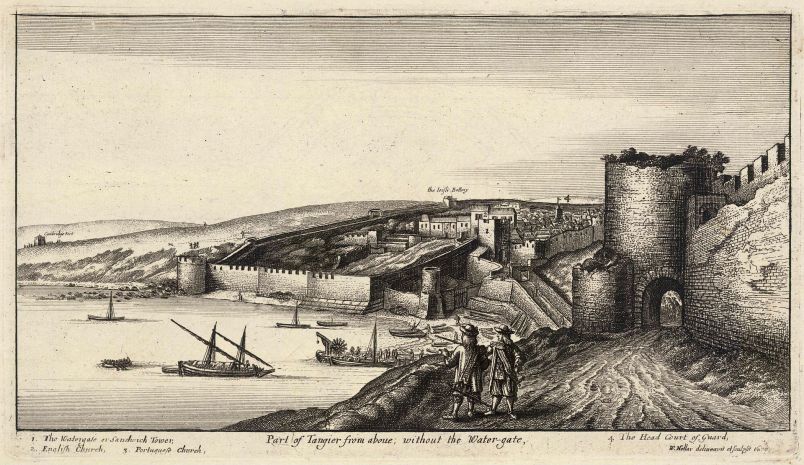Here is part of a letter written in 1684 …
“I desire to take boldness to propose a request. A vessel carried away a great number of our surprised Indians, in the time of our wars, to sell them for slaves; but the nations, whither they went, would not buy them. Finally, she left them at Tangier; there they be, so many as live, or are born there. And Englishman, a mason, came thence to Boston: he told me, they desired I would use some means for their return home. I know not what to do in it; but now it is in my heart to move your honour, so to meditate, that they may have leave to get home, either from thence hither, or from thence to England, and so to get home.”
This is the final portion of a letter written by John Eliot, who the Massachusetts Puritans somewhat grandiosely called “The Apostle to the Indians”, to Robert Boyle in November 1683. Boyle was one of the founders of modern chemistry and a pioneer of the scientific method. He also took an interest in the Native Americans of the English colonies. And here, in a final passage of the letter, Eliot reveals a nugget of information that was a matter of deep fascination for me when I was writing my dissertation in the 90s. New England was engulfed in a brutal, catastrophic war in 1676-77, one that led not only to massive loss of life on both sides but the death and expulsion of most of the Indian population within the core English area of settlement.
Key English settlers had fantasized since the 1630s about capturing the region’s Indian populations in war and shipping them abroad as slaves in trade for African slaves who would make a more tractable labor force. But during what was known as King Philip’s War, the fantasy suddenly became real.
Here though was an almost unbelievable story. One shipment of almost two hundred New England Indians were dumped off in the North African port of Tangier after the sea captain who had taken them out of New England could find no one to sell them to as slaves. Not only had these deported Algonquin ended up in North Africa. But they had managed, almost unimaginably, to get word back some eight years later asking their patron for help in returning to Massachusetts.
Cases like these make history irresistible. How could it have happened? How can we solve the mystery of how it did? The story captured and still captures for me both the boundlessness of the 17th century Atlantic and also its uncanny smallness, a world tossing together charging western Europeans, plundered Indians and Africans, North African Muslims, all bound together by a network of commerce, bondage and contending religions and ideologies.

John Eliot, Indian Missionary
From here I pick up the detective work from the unpublished text of my dissertation.
On a winter day in 1683, the seventy-nine year old Puritan missionary John Eliot wrote a letter to his friend Sir Robert Boyle. History knows Boyle as a natural philosopher, a chemist, and a founding member of the Royal Society. But Eliot knew him through their common interest in what the English called the “Indian work,” the Puritan mission to the New England Indians. Since the Restoration, Boyle had served as the President of the Society for the Propagation of the Gospel in New England, an office that brought him into contact not only with Eliot, but also with John Winthrop, Jr., Daniel Gookin, and other prominent New Englanders. On this day, however, Eliot wrote with a special request. A group of New England Indians living in Morocco had recently managed to contact Eliot and begged his assistance in bringing them home. Eliot was now asking Boyle if he could help.

English Tangier, circa 1680
Eliot’s letter resonates with palpable anguish. “I know not what to do in it,” he confided to Boyle, “but now it is in my heart to move your honour, so to meditate, that they may have leave to get home, either from thence hither, or from thence to England, and so to get home.” As Eliot went on to explain, these Indian refugees were a distant remnant of the massive expulsion of Indians which had occurred during and immediately after King Philip’s War eight years earlier. “A vessel carried away a great number of our surprised Indians,” he wrote, “in the time of our wars, to sell them for slaves.” But once these Indians were shipped off, they met with an unexpected and ambiguous fate, one that was actually common for the enslaved Indians sent out of New England during the war: “The nations, whither they went would not buy them.” Eventually, finding no ready market, they ended up at Tangier, the ancient Moroccan port town, which was an English possession from 1662 to 1684. And there they remained, wrote Eliot, “so many as live, or are born there.”

English Tangier, circa 1670
Before 1683, Eliot had known nothing of their fate. But earlier that year, the Indians had made contact with a Boston-bound Englishman in Tangier. And they prevailed upon him to carry their message to Eliot. In his letter to Boyle, Eliot says nothing about the identity of these particular Indians or whether he knew specifically who they were. But a close reading of Eliot’s letter combined with clues from other sources allow us to piece together what Eliot left unsaid. He almost certainly knew precisely who these Indians were: a group of one hundred and seventy-eight Indian captives who were shipped overseas on September 28th 1675 on board a ship captained by Richard Sprague, the first large-scale deportation of the war. Eliot had tried in vain to intercede on their behalf eight years earlier.
Richard Sprague had been in and out of New England ports in the year before King Philip’s War working as a privateer preying on Dutch shipping. The same was true of Samuel Moseley, the man responsible for capturing the Indians in question in Plymouth soon after the outbreak of hostilities. In 1674 New England had been drawn into the Third Anglo-Dutch war (1672-74); and in March of that year, the Massachusetts General Court had commissioned Sprague and Moseley to cruise Long Island Sound against Dutch shipping. When King Philip’s War broke out in June 1675, Moseley was in Boston recuperating from injuries suffered when a gun barrel on his ship, the Salisbury, exploded during a celebratory firing in Boston Harbor. He quickly raised a company of roughly one hundred men from Boston’s transient population of servants, sailors, privateers, and other unattached men. He did so with a commission from the Massachusetts General Court entitling him to the profits from the sale of those Indians he could capture in battle. Soon thereafter, he and his company were taking part in the initial fighting against Philip on Plymouth’s Mount Hope Peninsula and Pocasset Swamp. It was in these early engagements in Plymouth that Moseley first demonstrated the fierce anti-Indian spirit that would make him a folk hero in New England during the war — of which we will say more later.
The first contingents of the Massachusetts army under the command of Major Thomas Savage set out for Plymouth in late June. Once there, they fought first in the initial skirmishing with Philip on Mount Hope Peninsula and then, after Philip broke free of the Peninsula, in a series of desultory raids and mopping up operations on the eastern shore of Narragansett Bay. After one of these operations, an attack on Dartmouth on July 9th, a group of some eighty Indian non-combatants were persuaded to “come in” and surrender themselves to the English. Moseley promptly secured these captives in a house near Plymouth and returned to Massachusetts, where he sought instructions on how to dispose of them. The Massachusetts authorities instructed him to kill none who had been taken alive but to “secure them in Order to a Transportation.” These captives, along with two other groups captured during the same campaign under similar circumstances, were shipped away aboard Sprague’s ship in late September.
The destination of Sprague’s vessel provides the most compelling clue connecting his captives to the exiles at Tangier. Most, if not all, of the rest of the enslaved Indians captured during the war were shipped to the Caribbean. But Sprague’s ship was traveling to the Spanish port of Cadiz – which is some sixty miles from Tangier. Both ports are situated just on the Atlantic side of the Strait of Gibraltar, on the European and North African sides, respectively. What happened after Sprague reached Cadiz remains obscure. But by the following Spring, according to English admiralty records, the captives were working as galley slaves on English-oared ships at Tangier. How they got from one place to the other is unclear. Perhaps he found no buyers for them and left them off or sold them at Tangier, the nearest English port. Some controversy, however, seems to have surrounded their disposition because the last we hear of them prior to Eliot’s letter is a April 29th, 1676 admiralty ruling ordering that these “Indian slaves” be returned to Sprague at Cadiz. Since they were still at Tangier seven years later, however, it seems this never occurred.
Eliot’s letter provides other important clues. He writes of a single “vessel [which] carried away a great number of our surprised Indians.” The reference to a “vessel” seems to refer to a single and, presumably, specific ship. His description of their being “surprised” fits with the descriptions of the capture of the eighty Indians who Moseley took into captivity after the attack on Dartmouth as well as the capture of the other two groups eventually included on Sprague’s ship. Eliot knew about these events intimately for he had followed them closely as they occurred and later petitioned the General Court not to deport the captives in question. “All men (of reading) condemne the Spaniard for cruelty, upon this poynt,” he told the Governor and Council at Boston in August 1675, “in destroying men, & depopulating the land … [H]ere is land enough for them & us too.”
And what of the Indians’ fate? Here the story becomes more speculative since Eliot’s letter is the last known record of them. In the months just after the war a few Indian deportees managed to make their way back to New England from the West Indies. But there are no reports of mass returns, and certainly none at so late a date, or from so far away. The obstacles to doing so, even if Eliot and Boyle had been inclined to assist, would have been daunting. Bringing dozens of Indians from North Africa back to New England would have required an extraordinary feat of organization and substantial capital. If either had been forthcoming, there would be some trace of their efforts. But there is none.
It is extremely unlikely that any of these Indians made it back to New England. But it is less certain that they remained at Tangier. In 1678, the Sultan of Morocco, Mulay Ismail, had begun a long siege to Tangier. The English foothold was perpetually insecure and the cost of maintaining the town under English occupation grew substantial at a time when the Stuart monarchy was already under serious fiscal strain. After sounding out the Kings of France and Portugal as potential buyers of the town, in the middle of 1683 the King made the decision to abandon the outpost. In August 1683, Lord Dartmouth and Samuel Pepys left England with what were at first secret orders to manage the evacuation and destruction of Tangier. Through the Fall they arbitrated claims for compensation from the town’s freeholders, organized the evacuation of several thousand Europeans – mainly English soldiers and their wives – and prepared the town’s demolition. The English formally abandoned Tangier on February 4th, 1684 after blowing up most of the town’s principal fortifications.
Given what was occurring in Tangier from the late Summer of 1683, the timing of the Indians’ message to Eliot does not seem coincidental. Their plea for help in returning home might well have been made in the context of the preparations for evacuation then being made or their expectation that the end of the English occupation was not far off. With the number of ships taking residents out of Tangier that fall and winter, it seems possible some might well have been evacuated. The question turns on whether the English deemed the Indians worthy of evacuation. Ironically, being the property of some of the English evacuees might have made that more likely. We simply don’t know. After Eliot’s letter to Boyle, the record of these Algonquian exiles falls silent.








